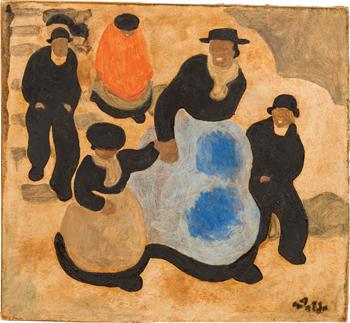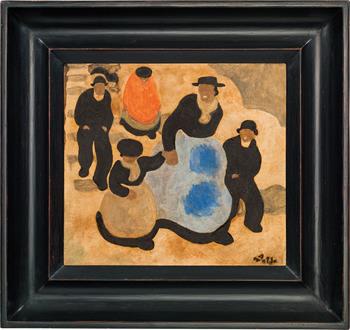0101
Alfons Walde*
(Oberndorf 1891 - 1958 Kitzbühel)
„Kirchstiege“
c. 1920
oil tempera on paper on cardboard; framed
27 x 29.5 cm
signed on the lower right: A / Walde
original label of the artist on the reverse of the cardboard
Provenance
Uta Ferlisi, formerly Anne Müller-Watzl, Kitzbühel;
acquired there by the uncle of the present owner on 13 January 1968 (invoice enclosed), private property, Austria
The work is registered in the Alfons Walde Archive.
Estimate: € 35.000 - 70.000
Result: € 43.560 (incl. fees)
Auction is closed.
Although Alfons Walde found essential artistic inspiration in the Secessionist and early Expressionist Vienna of the pre-war years, after the war he decided to stay in his hometown of Kitzbühel. Early on, he had transferred the ideas about form that he had adopted from Klimt and Schiele at the beginning of his artistic career to motifs from the rural and small-town milieu of the Kitzbühel area.
The figure of the farmer absorbed Walde throughout his painting years. In memorable images, he shows the farmer integrated in his landscape and living environment. He was not interested in the theme of farmwork, but rather in the atmosphere of Sundays and holidays. The motif “Kirchstiege" (“Church steps”) is based on the pictorial concept “Kirchgang” (“Walking to church”), which appeared as early as 1914 (cf. Gert Ammann, Alfons Walde, Innsbruck 2005, fig. p. 192) and which Alfons Walde developed further in this version from 1920 onwards. Here, churchgoers are depicted descending the church steps in festive costume after Sunday mass. In the carefully selected details of the picture, a woman churchgoer can be seen in the immediate foreground with a girl on her right hand and a boy on her left. Behind them follow a man and a woman in a red and orange cloak, while at the very top, cut off by the edge of the picture, a mere fragment of another figure can be vaguely surmised. The background is summarily hinted at with rapid brushstrokes. Walde skilfully adds momentum to his composition by contrasting the forward movement of the woman in the purple apron with her sideways gaze. He deliberately refrains from a more detailed physiognomic characterisation and elaboration of the individual and thus creates archetypes: his churchgoers are representative of a universally applicable situation.
(Claudia Mörth-Gasser)



